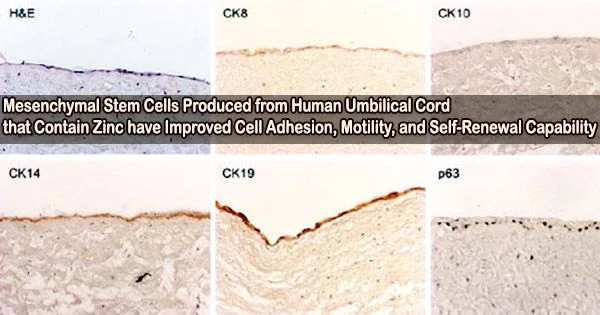After iron (Fe), zinc (Zn) is the trace element found in the human body in the second-highest concentration. Its insufficiency is regarded as a significant illness-contributing factor because it is commonly documented in conjunction with cell growth and proliferation.
Recently, a research team set out to evaluate how Zn affected the in vitro development and proliferation of mesenchymal stem cells (MSCs) obtained from the human umbilical cord (hUC).
The study is published in the World Journal of Stem Cells.
Within the research, hUC-MSCs were isolated from human umbilical cord tissue and characterized based on immunocytochemistry, immunophenotyping, and tri-lineage differentiation.
The MTT and Alamar blue assay were used to assess how Zn affected cytotoxicity and cell growth. To determine the effect of Zn on population doubling time (PDT), hUC-MSCs were cultured in media with and without Zn for several passages.
To examine how Zn affected the ability of hUC-MSCs to migrate and heal wounds, an in vitro scratch experiment was used. A cell adhesion assay was used to test the surface adhesiveness of hUC-MSCs.
Quantitative real-time polymerase chain reaction was used to analyze the transcription of genes involved in the cell cycle, proliferation, migration, and self-renewal of hUC-MSCs. The protein expression of Lin28, a pluripotency marker, was analyzed by immunocytochemistry.
Zn at lower concentrations enhanced the rate of proliferation but at higher concentrations (> 100 µM), showed concentration-dependent cytotoxicity in hUC-MSCs. hUC-MSCs treated with Zn exhibited a significantly greater healing and migration rate compared to untreated cells.
Zn also increased the cell adhesion rate, and colony-forming efficiency (CFE). In addition, Zn upregulated the expression of genes involved in the cell cycle (CDC20, CDK1, CCNA2, CDCA2), proliferation (transforming growth factor β1, GDF5, hypoxia-inducible factor 1α), migration (CXCR4, VCAM1, VEGF-A), and self-renewal (OCT4, SOX2, NANOG) of hUC-MSCs. Expression of Lin28 protein was significantly increased in cells treated with Zn.
The results of the study imply that zinc increases the rate of hUC-MSC proliferation, lowering the PDT and preserving the CFE. Additionally, Zn improves hUC-MSC adhesion, migration, and self-renewal. These results highlight the essential role of Zn in cell growth and development.





